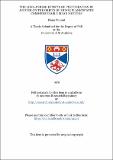The long-period effects of perturbation by Jupiter on the orbits of minor planets with commensurable mean motions
Abstract
Six minor planets with mean motions approximately commensurable with that of Jupiter were observed photographically: (87) Sylvia, (107) Camilla, (414) Liriope, (909) Ulla and (1574) Meyer (all with ratio 9/5), and (334) Chicago (ratio 3/2). The plates were measured on a two-coordinate measuring-machine, and reduced by the method of plate constants. Orbits were derived for all except (1574) Meyer; for (334) Chicago and for (909) Ulla, two orbits were obtained for successive years, though in the former case the orbits were not accurate. The orbits of all six planets were also integrated numerically by computer, together with that of (153) Hilda, using a technique applied to the latter planet by J. Schubart. Based on the three-body problem, this applies three mutually-perpendicular components of the disturbing force to the orbital parameters, which consequently vary with time. Short-period variables are eliminated by averaging; only the longitudes of the two planets are allowed to vary, around one cycle of the commensurability. The derivatives of the orbital elements are calculated at intervals around the cycle, and their average values used in the integration. Schubart's original method neglects the orbital inclinations of both planets; this investigation extends the equations to include the inclinations. His results for (153) Hilda are reproduced, and shown not to change greatly whether the inclinations are included or omitted. For (909) Ulla, however, considerable differences are found. The results of the integrations on all seven orbits are presented in the form of graphs, covering time-intervals of 3000 years and more. The orbit of (909) Ulla was integrated twice, once taking the ratio of mean motions as 9/5, and again as 7/4. The integrations of (153) Hilda and (334) Chicago took the ratio as 3/2. All the orbits considered appear stable over long time-intervals. The perihelion advance of (334) Chicago is interrupted by long retrogressions, as noted by Schubart. The orbit of (909) Ulla shows similar, though less marked, behaviour. Both planets are somewhat removed from exact commensurability. Comparison was made between the orbits of four of the planets, derived from observations, and the orbits predicted by the numerical integrations. In most cases, the orbital parameters changed in the direction predicted but .to a greater degree, indicating that more variables affect the real orbits of the minor planets than are taken into account in this theoretical investigation.
Type
Thesis, PhD Doctor of Philosophy
Collections
Items in the St Andrews Research Repository are protected by copyright, with all rights reserved, unless otherwise indicated.

